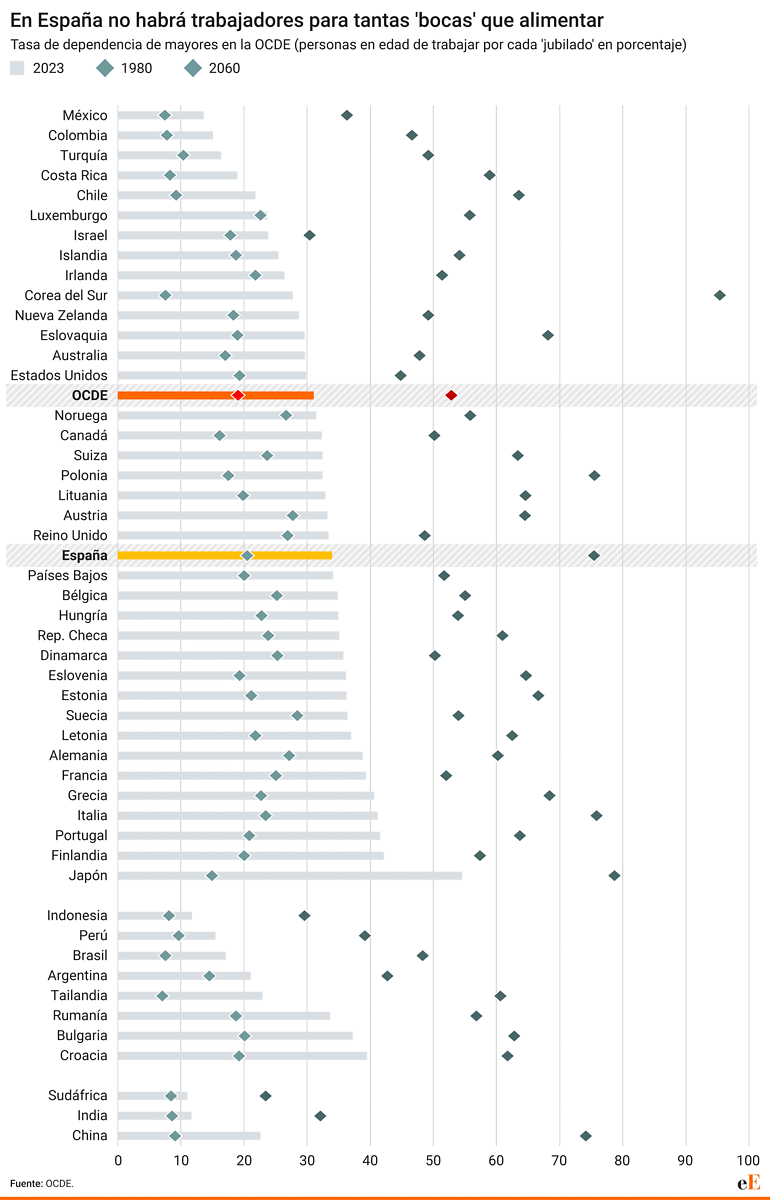There aren't enough workers in Spain to feed so many mouths: the economy will only grow 0.13% annually until 2060.

You can't perform magic. With a shrinking working-age population and a growing dependent population, only one outcome can occur (barring an unexpected miracle of productivity): much lower per capita GDP growth . The math is simple in this case. If a population of 20 has 15 of them of working age and working, while only 5 of them are elderly or children (dependent population, or more commonly: 'mouths' to feed ), it will be easy, in theory, to maintain the population and generate sufficient and growing production for everyone. Imagine another economy with 10 people of working age and another 10 who are not of working age (they are children or the elderly). The distribution of production (everything the economy produces) would be more complex, and potential growth lower. There are not enough workers for such a large population, which will depend on those who do produce or are of productive age . Something like this is what will happen to Spain, summarized in a very crude, simple, and colloquial way, in the coming years. The "elderly" population will continue to grow, while working-age citizens will constitute an increasingly smaller portion of the overall population, according to the latest OECD employment report .
Low fertility and high life expectancy will lead Spain to suffer the largest decline in employment relative to population by 2060 among all members of the Organization for Economic Cooperation and Development (OECD), which will have significant consequences for the country's economic growth, according to the organization that represents all developed countries. The employment rate in Spain is expected to fall by more than 10 percentage points, to around 55%. If real GDP per capita growth in Spain has already been disappointing in recent years (or rather, decades), what's coming is even worse. Per capita GDP, although imperfect, is one of the most valid indicators for analyzing a society's prosperity, at least in economic terms. Even if aggregate GDP increases significantly, if per capita GDP does not, citizens' quality of life will not improve.
Why could GDP per capita stagnate even further in Spain? As noted above, because the "productive" population is going to suffer a significant decline. Spain is an economy that almost chronically presents productivity problems. If we add to that a lower employment rate (productivity and employment are the two ways to obtain a higher GDP per capita), the result can only be extremely low growth . " This demographic change will have important consequences for Spain's economic growth," warns the OECD, noting that if productivity growth were to remain in line with its 2006-2019 average, GDP per capita would increase by only 0.13% annually until 2060, compared to the 0.53% recorded between 2006 and 2019.
Although the OECD does not analyze each group in depth, the "dependent" sectors extend beyond people who have reached retirement age, who constitute the bulk of dependents. We can also talk about children under 16, the inactive population (those who, despite being of working age, do not want to work), disability pensioners, or the temporarily unemployed, who can join the list of citizens who depend on the "wealth" generation of others.
There will be a shortage of workers for a growing dependent population in Spain. The Spanish case is one of the most serious, or perhaps the most serious, due to the rapid decline in the employment rate, but the OECD emphasizes that this is a widespread trend in advanced countries: "Population aging will lead to significant labor shortages and fiscal pressures," warned Mathias Cormann, Secretary-General of the OECD, noting that, by 2060, the working-age population will decline by 8% in the OECD and annual public spending on pensions and health care will increase by 3% of GDP.
Only Japan and Korea are worse off.A lower employment rate will be accompanied by a higher dependency ratio, reaching 75% for the "elderly" population (for every person of working age, there will be 0.75 people who have already retired), and an even higher total dependency ratio (including children). This means that by 2060, there will be one person in Spain who can produce almost every person who cannot, either because they have retired or because they are not yet of legal working age. Thus, what each person of working age produces (assuming unemployment disappears) will have to be "shared" in some way (taxes, solidarity, etc.) between two people. Hence the disastrous forecast for future GDP per capita growth. Spain has the worst dependency ratio in the world, surpassed only by Japan and South Korea.

Not only that, but slower GDP per capita growth may coincide with greater intergenerational inequality . "Baby boomers have enjoyed significantly higher income growth than younger cohorts over the past three decades. Unless we find ways to boost the incomes of younger cohorts, there will be growing intergenerational inequality," the OECD warns.
In Spain, older working-age people (55-64) have experienced faster income growth than younger working-age people (25-34). In 1995, the equivalent disposable household income of young adults was 1.3% higher than that of the oldest age group. This trend reversed in the 2000s, and by 2022, older working-age people had incomes 5.6% higher than those of the youngest group.
"Ambitious policy measures are needed to improve employment opportunities for older workers, tap the untapped labor potential of women and young people, and revive productivity growth, ensuring, among other things, that workers have the skills they need to benefit from new AI tools," Cormann concluded.
The millennial drama"Furthermore, Spanish millennials ( those born after the 1980s ) have experienced limited income growth throughout their adult lives, partly due to stagnant labor productivity growth in recent decades and the lasting impact of the global financial crisis," the OECD warns.
To avoid this scenario of low GDP per capita growth, inequality, and low potential GDP, OECD experts believe Spain should regularize immigrants to increase its labor force. The OECD believes that by mobilizing untapped labor resources (reducing the discouraged population, equalizing the employment rate between men and women, for example), including by reducing the gender employment gap by at least two-thirds, as well as activating older workers in good health and promoting regular migration, Spain could boost annual GDP per capita growth to 0.73% , exceeding its recent historical trend.
Even if these reforms are implemented, the situation is not simple: "Younger generations will face the economic and social challenges arising from the aging of the population," warns the OECD, which believes that extending working life in Spain would not only help free up additional labor resources to support economic growth but would also ease the burden borne by young people, who are already experiencing income stagnation. Thus, the trends expected to dominate Spain's economy in the coming years are the following: policies to encourage employment at older ages or for people who prefer not to work, while simultaneously seeking to reduce the still high unemployment rate ; extending the retirement age; attracting immigration to strengthen the workforce; and seeking policies or fiscal frameworks that help reduce inequality between generations.
Younger generations will face the economic and social challenges arising from an aging population. Therefore, extending working life in Spain would not only help free up additional labor resources to support economic growth, but would also ease the burden on young people, who are already experiencing stagnant incomes.
eleconomista





